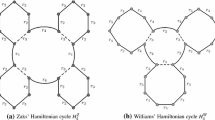Abstract
Perfect \(t\)-deletion-correcting codes of length \(n\) over the alphabet of size \(q\), denoted by perfect \((n,t)_q\text {-DCCs}\), can have different number of codewords, because the balls of radius \(t\) with respect to Levenshteĭn distance may be of different sizes. Thus determining all possible sizes of a perfect \(t\)-deletion-correcting code makes sense. When \(t=n-2\), \(t\)-deletion-correcting codes are closely related to directed packings, constructions of which are based on the tools of design theory. Recently, Chee, Ge and Ling determined completely the spectrum of possible sizes for perfect \(q\)-ary 1-deletion-correcting codes of length three for all \(q\), and perfect \(q\)-ary 2-deletion-correcting codes of length four for all but \(19\) values of \(q\). In this paper, we continue to investigate the spectrum problem for perfect \((4,2)_q\text {-DCCs}\). By constructing a considerable number of incomplete directed packings, we give an almost complete solution to the spectrum problem of sizes for perfect \((4,2)_q\text {-DCCs}\), leaving the existence of \((4,2)_{19}\text {-DCC}\) of size \(62\) and \((4,2)_{34}\text {-DCC}\) of size \(196\) in doubt.
Similar content being viewed by others
References
Bours P.A.H.: On the construction of perfect deletion-correcting codes using design theory. Des. Codes Cryptogr. 6, 5–20 (1995).
Chee Y.M., Ge G., Ling A.C.H.: Spectrum of sizes for perfect deletion-correcting codes. SIAM J. Discret. Math. 24, 33–55 (2010).
Colbourn C.J., Dinitz J.H. (eds.): CRC Handbook of Combinatorial Designs. CRC Press, Boca Raton (1996).
Ge G., Ling A.C.H.: Group divisible designs with block size four and group type \(g^{u}m^{1}\) for small \(g\). Discret. Math. 285, 97–120 (2004).
Ge G., Rees R.: On group-divisible designs with block size four and group-type \(6^{u}m^{1}\). Discret. Math. 279, 247–265 (2004).
Hartman A.: On small packing and covering design with block size \(4\). Discret. Math. 59, 275–281 (1986).
Immink K.A.S.: Codes for Mass Data Storage Systems, 2nd edn. Shannon Foundation Publishers, Eindhoven (2004).
Kinniment D.J.: Synchronization and Arbitration in Digital Systems. Wiley, Hoboken (2008).
Levenshteĭn V.I.: Binary codes capable of correcting deletions, insertions, and reversals. Sov. Phys. Dokl. 10, 707–710 (1965).
Levenshteĭn V.I.: Perfect codes in the metric of deletions and insertions. Discret. Math. 3, 3–20 (1991).
Marron M., Swenson K.M., Moret B.M.E.: Genomic distances under deletions and insertions. In: Computing and Combinatorics. Lecture Notes in Computer Science, vol. 2697, pp. 537–547. Springer, Berlin (2003).
Pratt C.W., Cornely K.: Essential Biochemistry. Wiley, New York (2004).
Sarvate D.G.: Some results on directed and cyclic designs. Ars Combin. 19, 179–190 (1985).
Shalaby N., Wang J., Yin J.: Existence of perfect \(4\)-deletion-correcting codes with length six. Des. Codes Cryptogr. 27, 145–156 (2002).
Sklar B.: Digital Communications: Fundamentals and Applications, 2nd edn. Prentice Hall Communications Engineering and Emerging Technologies Series, New Jersey (2001).
Wang J.: Some combinatorial constructions for optimal perfect deletion-correcting codes. Des. Codes Cryptogr. 48, 331–347 (2008).
Wang J., Shen H.: Existence of \((v, K_{1(3)} \cup \{w^{*}\})\)-PBDs and its applications. Des. Codes Cryptogr. 46, 1–16 (2008).
Wang J., Yin J.: Constructions for perfect 5-deletion-correcting codes of length \(7\). IEEE Trans. Inf. Theory 52, 3676–3685 (2006).
Yin J.: A combinatorial construction for perfect deletion-correcting codes. Des. Codes Cryptogr. 23, 99–110 (1999).
Acknowledgments
This research supported by the National Natural Science Foundation of China under Grant No. 61171198 and Zhejiang Provincial Natural Science Foundation of China under Grant No. LZ13A010001. The authors express their gratitude to the two anonymous reviewers for their detailed and constructive comments which are very helpful to the improvement of the technical presentation of this paper.
Author information
Authors and Affiliations
Corresponding author
Additional information
Communicated by D. Jungnickel.
Rights and permissions
About this article
Cite this article
Wei, H., Ge, G. Spectrum of sizes for perfect 2-deletion-correcting codes of length 4. Des. Codes Cryptogr. 74, 127–151 (2015). https://doi.org/10.1007/s10623-013-9848-x
Received:
Revised:
Accepted:
Published:
Issue Date:
DOI: https://doi.org/10.1007/s10623-013-9848-x



